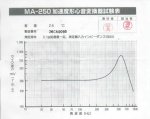Scooter B
New member
I am attaching a frequency response graph for a "microphone" that peaks between 300Hz and 700Hz with a rapid drop off after 700Hz.
For all intents and purposes it is a microphone but it was not designed for music recording applications.
Can you guess what it was designed for? (One hint it is a contact mic)
Could you think of any good uses for it in musical recording?
For all intents and purposes it is a microphone but it was not designed for music recording applications.
Can you guess what it was designed for? (One hint it is a contact mic)
Could you think of any good uses for it in musical recording?



 but not quite.
but not quite.



